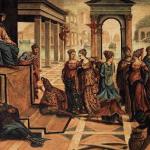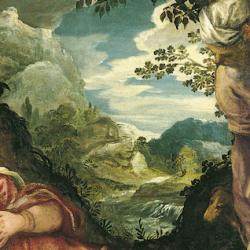In his Religious Philosophy of Vladimir Solovyov, Jonathan Sutton lays out Solovyov’s (Solovyev; Soloviev) conception of “free theocracy.”
For Solovyov, “the realization of the Kingdom of God on earth is presented as an ordering of all aspects of life (individual and communal life) according to Christian principles. Furthermore, this enterprise of conforming earthly life to its heavenly model should be animated by the spirit of Christian love (agape). This ideal, heavenly order is not imposed on man; rather, it is intended to free him from the purely natural level of existence, which is itself restrictive for man.”
It is only within the Kingdom of God that man can “attain his full stature, overcoming the natural state of alienation (otchuzhdenie) and attaining ‘plenitude of being’ (polnota bytiya). The natural mode of earthly existence, which comprises alienation, mutual hostility, rivalry of interests (individual, class and national interests)13 harms and diminishes man, obscures the ‘image of God’ in him.”
This is, for Solovyov, a collective enterprise, directing all institutions toward the fulfillment of human existence, But it cannot be done at the expense of human freedom: “government, the Church, and men’s other social institutions need to be administered so as to preserve the autonomy of individual members of the community, while legislation must be directed to defining the minimal degree of restraint necessary for the general welfare and freedom of all (54-5). Throughout his writings, he “reiterates his firm conviction that spiritual salvation is not simply a quest for isolated individuals to pursue. The summum bonum that particular individuals seek to attain must, by its very nature, be the summum bonum for all mankind” (79).
Solovyov’s model is largely drawn from the Old Testament: “He saw many merits in the Jewish understanding and application of theocratic rule, and for his own scheme he relied heavily upon the Judaic model, but judged that the fullest, most consistent adherence to theocratic principles is to be found specifically in the Christian Tradition.” He doesn’t see a sharp distinction between old and new on this score: “According to Solovyov, Judaism and Christianity accept one and the same goal – a universal theocracy – but Christianity also provides the path to the attainment of that goal” (78).
Theocratic politics will seek above all to fulfill spiritual needs, refusing to sacrifice them to “more utilitarian, secular considerations.” Different offices exist within the theocracy to fulfill the human vocation: “In the theocratic scheme formulated by Solovyov there are three representatives of authority: the High Priest (pervosvyashchennik), the King (tsar’) and the Prophet (prorok). Each of these three figures has particular responsibilities towards the community (as will be specified below), and each in his way, guides the community towards a consistent enactment or realization of God’s will.” Solovyov links the different authorities of the state to their characteristic times: “The High Priest has authority based on tradition (representing past time); the King has power founded upon the law (representative of present time); the Prophet has the freedom of personal initiative (representative of future time)” (80).
Priests are charged with the care of the soul, and since the care of the soul is the highest aim, the priests have the greatest authority. Whether or not the authority of priests is explicitly established by law, “the relationship between the leaders of the priestly order and the temporal ruler must be determined according to a clear set of criteria acceptable to the community at large.” Priestly power is a check on the aspirations and ambitions of the state: “The presence of a figure in the state who derives his authority from a source other than the temporal ruler can naturally give rise to disputes and rivalry. It is therefore especially necessary that the mutual relationship between the representatives of spiritual authority and of temporal authority be seen to rest upon principles laid down in accepted Scripture” (79).












